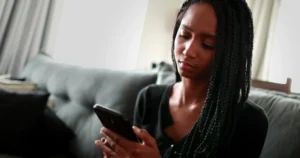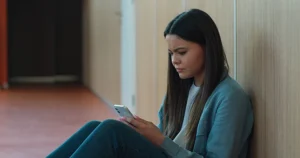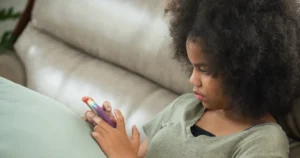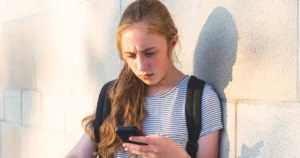Online hate facts & advice
Learn how hate takes shape online and what you can do to keep children safe with advice below.
What is online hate?
Online hate is language or actions that target a characteristic of a person or group of people in the digital space.
Many of those characteristics are protected by law. These include race or ethnicity, age, gender, sexual orientation, religion and more. This means that places of work and education as well as other areas cannot take action based on these characteristics.
Rules against online hate are set by communities online. So, moderation teams may ban someone from sharing their content if it is hateful or harmful. If your child comes across online hate, encourage them to report the user to help moderation teams review this content. This can help create more positive spaces online.
What is on this page
- Prevent hate against girls
- Challenge racism
- Recognise and stop ableism online
- Tackle religious discrimination
- Stop hate against LGBTQ+
Prevent hate against girls
Misogyny is the hate and discrimination against women and girls. This hate is spread through different online communities, which are a part of the ‘manosphere’.
It might include language that suggests women are not equal to men and should fit into certain gender stereotypes. Some messaging also encourages boys and men to treat women poorly or like a separate species. All of this can be very harmful towards young men’s understanding of positive relationships and young women’s sense of self and safety.
Explore one girl’s experience with misogyny in online football forums and what her dad does to establish a counter narrative.
 Close video
Close video


Misogyny from influencers
Learn how one dad tackles the influence of celebrity and social media with his sons.
 Close video
Close video
Misogyny impact on girls
Dad, Barney, shares his daughter’s experience with misogyny online.

Research into misogyny
Learn how one dad tackles the influence of celebrity and social media with his sons.
Challenge racism
Racism is discrimination based on ethnicity or skin colour. It is widespread and, in some cases, unnoticed by those who spread it, especially children. For example, calling a friend a racial slur in a video game might be laughed off, but it normalises the term and spreads online hate. It may also desensitise children to racism when they see it.
Racism can look like many things online, including hateful language, slurs and blanket statements. It may appear in videos, comments, voice chat and images across social media and video gaming communities.
Racism is a type of online hate. When someone reports racist behaviour to a community, the moderators can review and remove the content or user as needed. So, it’s important to encourage children to report anything racist they see or experience online.
Even when reported, some racist content or the user spreading racism may stay up. This could be due to a lack of context or misunderstanding. As such, in addition to reporting, encourage children to block the user spreading that hate. Additionally, they may be able to customise their social feed so they no longer see similar content.
Help children learn to recognise and tackle online hate like racism with the The Online Together Project and the Tackling Online Hate quiz.
- True Vision: Report Racist Hate Crime: Report racism, including hate speech and attacks targeting race online to the police with this reporting tool.
- Report Issues: Most social media platforms do not allow hate speech at all. See how to report racism on different social platforms.
- Stop Hate UK: 24-hour reporting services: Serving different areas, these reporting services can help empower children and young people to take action to stop racism they see online.
Recognise and stop ableism online
Ableism and disablism are types of online hate linked to disability. Ableism discriminates in favour of those who are able-bodied while disablism discriminates against those with disabilities. They both impact those with disabilities. Disabilities can refer to physical or mental disabilities.
Disabilities are protected characteristics under UK law. Online hate that spreads ableism or disablism should be reported on the platform or to relevant authorities.
Stop ableist and disablist language. Online hate that discriminates against disability can look like different things. It might be content that makes fun of someone who has a physical or mental impairment. It could be comments or language that suggests people without disabilities are better than those with disabilities. This kind of online hate might even be content that assumes what someone with a disability can or cannot do.
Encourage children to report any content that promotes online hate against people with disabilities. They should also block users who continue to share hateful content.
They may also work to counter online hate against people with disabilities by sharing positive messages with those affected. Or, they could support content creators who share their experiences with their disability. Supporting content that spreads awareness and informs followers is a great way to counter online hate.
- Inclusive Digital Safety hub: Learn how to help children and young people with SEND have positive and safe experiences online.
- Scope: Recognising and reporting disability hate crime: Learn how you can report hate crime based on disability.
- True Vision: Disability Hate Crime: Learn about disability hate crime and get additional guidance on supporting young people who may be victim to online ableism or disablism.
Tackle religious discrimination
Religious discrimination is when someone receives different treatment than someone else because of their religion or beliefs. It is illegal to discriminate against someone based on this protected characteristic.
Online hate against religion can take many forms. Some hate related to religion may also share links to racism. Additionally, religious discrimination may include blanket statements about ‘all people’ who believe in something. It can be seen on social media, in video games, in online communities and other digital spaces.
As with any type of online hate, encourage children to report those spreading misinformation or hate about any religion or belief system. Whether it’s targeted at them or not, online hate can affect anyone.
Show kids how to block users on their favourite platforms if they discriminate against others based on religion. Talk to your child about the different forms of religious discrimination and how hateful content might influence radicalisation.
It’s also important to think about the counter narrative. Instead of arguing with people about religion online, encourage young people to share positive messages of support to those who might feel targeted. However, make sure they remember not to get drawn into online arguments.
- Citizens Advice: Discrimination because of religion or belief: Learn more about religious discrimination and how to get support.
- True Vision: Religious hate crime: Learn more about religious discrimination and see options for reporting online hate targeting religion.
- EHRC: Religion or belief discrimination: Learn more about the law behind this protected characteristic.
Stop hate against LGBTQ+
- Homophobia is hate against someone who is gay (a man attracted to men) or a lesbian (a woman attracted to women). Some may also use it to refer to other members of the LGBTQ+ community. However, other terms like biphobia and transphobia refer to those specific identities.
- Biphobia is the hate and prejudice against people who identify as bisexual (attracted to both men and women).
- Transphobia is the hate and prejudice against people who are transgender (identifies as a different gender from the one they were assigned at birth).
Sometimes the hate people online share may call people in the LGBTQ+ community derogatory names or slurs. In other cases, people might spread misinformation about those who are a part of the community. While the information they spread is untrue, it still creates fear. This not only leads to more hate but also targets vulnerable children and young people who may be searching for support as they discover their identity, whether that be a part of the LGBTQ+ community or not.
Some social media platforms, for example, may connect hateful posts with hashtags that seem unrelated. The #grooming hashtag, for instance, connects people accusing those in the LGBTQ+ community of grooming because of their transgender identity or dressing in drag. However, this spreads misinformation about what grooming really is, which in turn increases the risk of online harm to children. In cases like this, you can report the hashtag to the platform.
Encourage children to report online hate against the LGBTQ+ community. Also, providing additional information for context can help moderators understand why something is being reported as hate. Without that context, content might not be taken down. Explain that they might have to report content multiple times to get it removed, but they should continue to do so.
- True Vision: Sexual Orientation and Transgender Hate Crime: Report hate against the LGBTQ+ community, including hate speech and attacks targeting gender identity or sexual orientation online.
- Galop: Get Help: Learn how to get help with hate against the LGBTQ+ community.
- Find guidance to help children and young people who identify as LGBTQ+ have safe and positive experiences online.
Latest online hate featured articles
 Research
Research
A year on: ‘Nudifying’ tools remain easy to access – and just as harmful
A year on from our report, see what still remains unchanged when it comes to nudifying tools available online.
 Q&A
Q&A
Why can’t I find the right digital space for my pre-teen?
Online safety experts from a range of backgrounds share their insights and tips into the lack of specific spaces designed for pre-teens.
 Expert opinion
Expert opinion
Protecting children from online violence
Learn how exposure to violent content online impacts young users.
 Research
Research
Me, myself and AI chatbot research
Explore findings around children's use of AI chatbots and the impacts it could have on their digital wellbeing.
 Q&A
Q&A
Should children watch Netflix’s ‘Adolescence’ in school?
Experts share potential issues with showing the Netflix series 'Adolescence' in schools.


